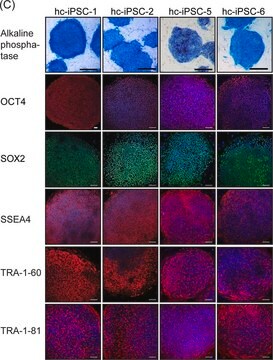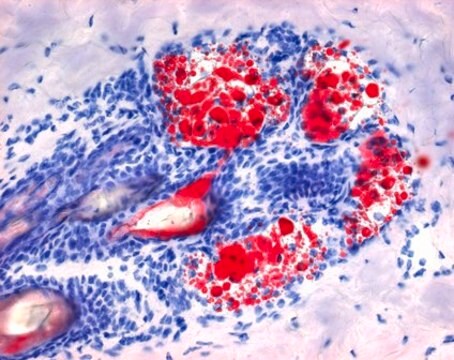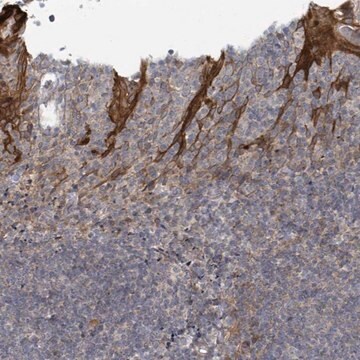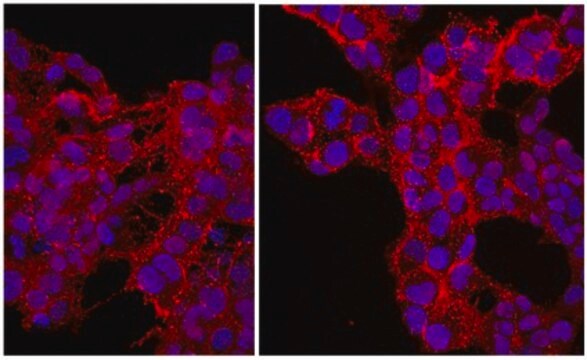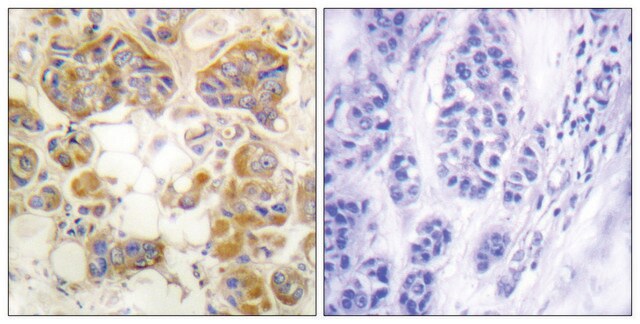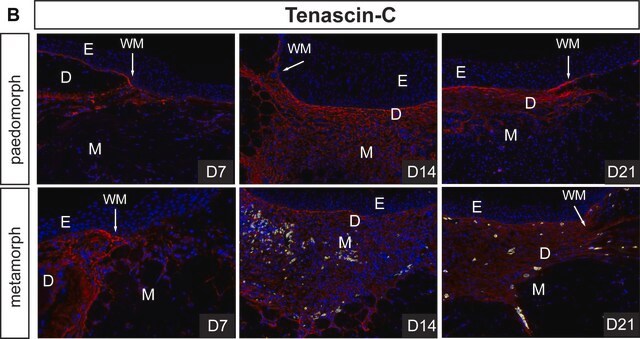おすすめの製品
由来生物
mouse
品質水準
結合体
ALEXA FLUOR™ 488
抗体製品の状態
purified antibody
抗体製品タイプ
primary antibodies
クローン
TRA - 1-60, monoclonal
化学種の反応性
human
テクニック
immunocytochemistry: suitable
アイソタイプ
IgM
輸送温度
wet ice
ターゲットの翻訳後修飾
unmodified
遺伝子情報
human ... PODXL(5420)
詳細
Human embryonal carcinoma (EC) cells are the stem cells of teratocarcinomas, and they are key components of germ cell tumors (GCTs). They express several high molecular weight glycoprotein antigens that are down-regulated upon differentiation. One of these antigens, defined by monoclonal antibody TRA-1-60, can be detected in the serum of GCT patients and provides a useful complement to the established serum markers human chorionic gonadotropin and α-fetoprotein, especially in those patients without elevated serum human chorionic gonadotropin or α-fetoprotein.
特異性
This antibody reacts with TRA-1-60 antigen expressed upon the surface of human EC, EG, and ES cells. No immunoreactivity is seen with murine EC, EG or ES cells. TRA-1-81 (MAB4381A4) and TRA-1-60 monoclonal antibodies recognize antigens that are associated with a pericellular matrix proteoglycan.
免疫原
Human embryonal carcinoma cell line 2102Ep
アプリケーション
Research Category
ニューロサイエンス
ニューロサイエンス
Detect TRA-1-60 using this Anti-TRA-1-60 Antibody, clone TRA-1-60, Alexa Fluor 488 Conjugate validated for use in IC.
品質
Evaluated by Immunocytochemistry in H9 human embryonic stem cells.
Immunocytochemistry Analysis: A 1:200 dilution of this antibody detected TRA-1-60 in H9 human embryonic stem cells.
Immunocytochemistry Analysis: A 1:200 dilution of this antibody detected TRA-1-60 in H9 human embryonic stem cells.
物理的形状
size exclusion
Purified mouse monoclonal IgM conjugated to Alexa Fluor™ 488 in PBS with 0.1% sodium azide and 15 mg/mL BSA.
保管および安定性
Stable for 1 year at 2-8°C from date of receipt.
アナリシスノート
Control
H9 human embryonic stem cells
H9 human embryonic stem cells
法的情報
ALEXA FLUOR is a trademark of Life Technologies
免責事項
Unless otherwise stated in our catalog or other company documentation accompanying the product(s), our products are intended for research use only and are not to be used for any other purpose, which includes but is not limited to, unauthorized commercial uses, in vitro diagnostic uses, ex vivo or in vivo therapeutic uses or any type of consumption or application to humans or animals.
適切な製品が見つかりませんか。
製品選択ツール.をお試しください
保管分類コード
12 - Non Combustible Liquids
WGK
WGK 2
引火点(°F)
Not applicable
引火点(℃)
Not applicable
適用法令
試験研究用途を考慮した関連法令を主に挙げております。化学物質以外については、一部の情報のみ提供しています。 製品を安全かつ合法的に使用することは、使用者の義務です。最新情報により修正される場合があります。WEBの反映には時間を要することがあるため、適宜SDSをご参照ください。
Jan Code
MAB4360A4:
試験成績書(COA)
製品のロット番号・バッチ番号を入力して、試験成績書(COA) を検索できます。ロット番号・バッチ番号は、製品ラベルに「Lot」または「Batch」に続いて記載されています。
Yohei Hayashi et al.
Communications biology, 1, 218-218 (2018-12-12)
Conventional cell handling and sorting methods require manual labor, which decreases both cell quality and quantity. To purify adherent cultured cells, cell purification technologies that are high throughput without dissociation and can be utilized in an on-demand manner are expected.
Kung-Kai Kuo et al.
Stem cells (Dayton, Ohio), 34(11), 2613-2624 (2016-06-25)
The network of stemness genes and oncogenes in human patient-specific reprogrammed cancer stem cells (CSCs) remains elusive, especially in liver cancer. HepG2-derived induced pluripotent stem cell-like cells (HepG2-iPS-like cells) were generated by introducing Yamanaka factors and the knockdown vector shTP53.
Ning Sun et al.
Proceedings of the National Academy of Sciences of the United States of America, 106(37), 15720-15725 (2009-10-07)
Ectopic expression of transcription factors can reprogram somatic cells to a pluripotent state. However, most of the studies used skin fibroblasts as the starting population for reprogramming, which usually take weeks for expansion from a single biopsy. We show here
Vanessa Sauer et al.
Cell transplantation, 25(12), 2221-2243 (2016-08-12)
Although several types of somatic cells have been reprogrammed into induced pluripotent stem cells (iPSCs) and then differentiated to hepatocyte-like cells (iHeps), the method for generating such cells from renal tubular epithelial cells shed in human urine and transplanting them
ライフサイエンス、有機合成、材料科学、クロマトグラフィー、分析など、あらゆる分野の研究に経験のあるメンバーがおります。.
製品に関するお問い合わせはこちら(テクニカルサービス)